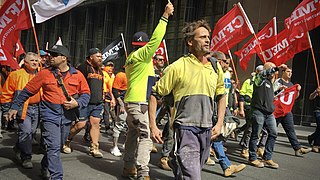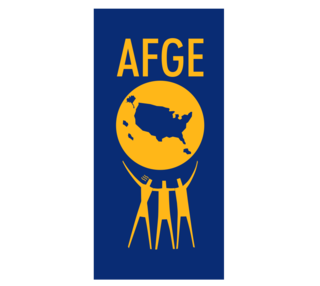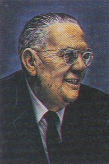
The National Labor Relations Act of 1935, also known as the Wagner Act, is a foundational statute of United States labor law that guarantees the right of private sector employees to organize into trade unions, engage in collective bargaining, and take collective action such as strikes. Central to the act was a ban on company unions. The act was written by Senator Robert F. Wagner, passed by the 74th United States Congress, and signed into law by President Franklin D. Roosevelt.

The Labor Management Relations Act of 1947, better known as the Taft–Hartley Act, is a United States federal law that restricts the activities and power of labor unions. It was enacted by the 80th United States Congress over the veto of President Harry S. Truman, becoming law on June 23, 1947.

Strike action, also called labor strike, labour strike, or simply strike, is a work stoppage caused by the mass refusal of employees to work. A strike usually takes place in response to employee grievances. Strikes became common during the Industrial Revolution, when mass labor became important in factories and mines. As striking became a more common practice, governments were often pushed to act. When government intervention occurred, it was rarely neutral or amicable. Early strikes were often deemed unlawful conspiracies or anti-competitive cartel action and many were subject to massive legal repression by state police, federal military power, and federal courts. Many Western nations legalized striking under certain conditions in the late 19th and early 20th centuries.
Collective bargaining is a process of negotiation between employers and a group of employees aimed at agreements to regulate working salaries, working conditions, benefits, and other aspects of workers' compensation and rights for workers. The interests of the employees are commonly presented by representatives of a trade union to which the employees belong. A collective agreement reached by these negotiations functions as a labour contract between an employer and one or more unions, and typically establishes terms regarding wage scales, working hours, training, health and safety, overtime, grievance mechanisms, and rights to participate in workplace or company affairs. Such agreements can also include 'productivity bargaining' in which workers agree to changes to working practices in return for higher pay or greater job security.
In the context of labor law in the United States, the term "right-to-work laws" refers to state laws that prohibit union security agreements between employers and labor unions which require employees who are not union members to contribute to the costs of union representation. Unlike the right to work definition as a human right in international law, U.S. right-to-work laws do not aim to provide a general guarantee of employment to people seeking work but rather guarantee an employee's right to refrain from paying or being a member of a labor union.

The American Federation of Government Employees (AFGE) is an American labor union representing over 670,000 employees of the federal government, about 5,000 employees of the District of Columbia, and a few hundred private sector employees, mostly in and around federal facilities. AFGE is the largest union for civilian, non-postal federal employees and the largest union for District of Columbia employees who report directly to the mayor. It is affiliated with the AFL–CIO.
Jerome Wurf was a U.S. labor leader and president of the American Federation of State, County and Municipal Employees (AFSCME) from 1964 to 1981. Wurf was a friend of Martin Luther King Jr., and was arrested multiple times for his activism, notably during the Memphis sanitation strike. He was present for King's "I've Been to the Mountaintop" oratory at the strike, the day before King was assassinated, and attended King's funeral.

Union busting is a range of activities undertaken to disrupt or prevent the formation of trade unions or their attempts to grow their membership in a workplace.
The National Labor Board (NLB) was an independent agency of the United States Government established on August 5, 1933, to handle labor disputes arising under the National Industrial Recovery Act (NIRA).

District Council 37 is New York City's largest public sector employee union, representing over 150,000 members and 50,000 retirees.

George W. Taylor was a professor of industrial relations at the Wharton School at the University of Pennsylvania, and is credited with founding the academic field of study known as industrial relations. He served in several capacities in the federal government, most notably as a mediator and arbitrator. During his career, Taylor settled more than 2,000 strikes.

The Public Safety Employer-Employee Cooperation Act of 2007, introduced in the 110th Congress(H.R. 980, S. 2123), proposed to establish minimum standards for state collective bargaining laws for public safety officers.

The American Federation of State, County and Municipal Employees (AFSCME) is the largest trade union of public employees in the United States. It represents 1.3 million public sector employees and retirees, including health care workers, corrections officers, sanitation workers, police officers, firefighters, and childcare providers. Founded in Madison, Wisconsin, in 1932, AFSCME is part of the AFL–CIO, one of the two main labor federations in the United States. AFSCME has had four presidents since its founding.
Communications Workers of America v. Beck, 487 U.S. 735 (1988), is a decision by the United States Supreme Court which held that, in a union security agreement, unions are authorized by statute to collect from non-members only those fees and dues necessary to perform its duties as a collective bargaining representative. The rights identified by the Court in Communications Workers of America v. Beck have since come to be known as "Beck rights," and defining what Beck rights are and how a union must fulfill its duties regarding them is an active area of modern United States labor law.
The State, County, and Municipal Workers of America (SCMWA) was an American labor union representing state, county, and local government employees. It was created by the Congress of Industrial Organizations (CIO) in 1937 along with United Federal Workers of America. SCMWA's leaders Abram Flaxer and Henry Wenning had been leaders of the Association of Workers of Public Relief Agencies (AWPRA) in New York City prior to the formation of SCMWA.
A public-sector trade union is a trade union which primarily represents the interests of employees within public sector or governmental organizations.
Abood v. Detroit Board of Education, 431 U.S. 209 (1977), was a US labor law case where the United States Supreme Court upheld the maintaining of a union shop in a public workplace. Public school teachers in Detroit had sought to overturn the requirement that they pay fees equivalent to union dues on the grounds that they opposed public sector collective bargaining and objected to the political activities of the union. In a unanimous decision, the Court affirmed that the union shop, legal in the private sector, is also legal in the public sector. They found that non-members may be assessed agency fees to recover the costs of "collective bargaining, contract administration, and grievance adjustment purposes" while insisting that objectors to union membership or policy may not have their dues used for other ideological or political purposes.
A public-sector trade union is a trade union which primarily represents the interests of employees within public sector or governmental organizations.

AFSCME Council 31 is the Illinois state chapter of the American Federation of State, County and Municipal Employees (AFSCME), a union of public service workers in the public, private and non-profit sectors. AFSCME Council 31 has "100,000 active and retired members", including "approximately 40,000 state employees working in more than 50 departments, authorities, boards, and commissions under the authority of the Governor."
Janus v. American Federation of State, County, and Municipal Employees, Council 31, No. 16-1466, 585 U.S. ___ (2018), abbreviated Janus v. AFSCME, was a landmark decision of the US Supreme Court on US labor law, concerning the power of labor unions to collect fees from non-union members. Under the Taft–Hartley Act of 1947, which applies to the private sector, union security agreements can be allowed by state law. The Supreme Court ruled that such union fees in the public sector violate the First Amendment right to free speech, overturning the 1977 decision in Abood v. Detroit Board of Education that had previously allowed such fees.







